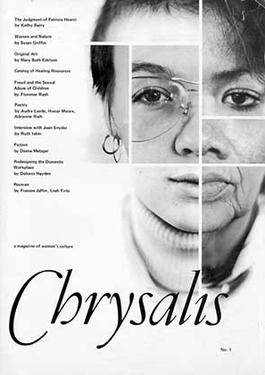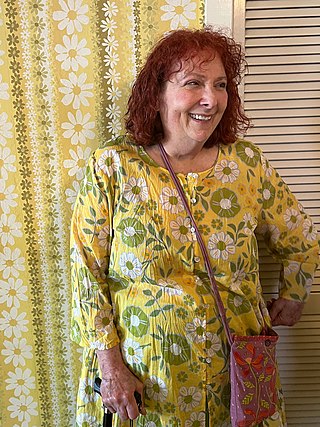
Judy Chicago is an American feminist artist, art educator, and writer known for her large collaborative art installation pieces about birth and creation images, which examine the role of women in history and culture. During the 1970s, Chicago founded the first feminist art program in the United States at California State University, Fresno which acted as a catalyst for feminist art and art education during the 1970s. Her inclusion in hundreds of publications in various areas of the world showcases her influence in the worldwide art community. Additionally, many of her books have been published in other countries, making her work more accessible to international readers. Chicago's work incorporates a variety of artistic skills, such as needlework, counterbalanced with skills such as welding and pyrotechnics. Chicago's most well known work is The Dinner Party, which is permanently installed in the Elizabeth A. Sackler Center for Feminist Art at the Brooklyn Museum. The Dinner Party celebrates the accomplishments of women throughout history and is widely regarded as the first epic feminist artwork. Other notable art projects by Chicago include International Honor Quilt, Birth Project, Powerplay, and The Holocaust Project. She is represented by Jessica Silverman gallery.
Amelia Jones, originally from Durham, North Carolina, is an American art historian, art theorist, art critic, author, professor and curator. Her research specialisms include feminist art, body art, performance art, video art, identity politics, and New York Dada. Jones's earliest work established her as a feminist scholar and curator, including through a pioneering exhibition and publication concerning the art of Judy Chicago; later, she broadened her focus on other social activist topics including race, class and identity politics. Jones has contributed significantly to the study of art and performance as a teacher, researcher, and activist.
The Woman's Building was a non-profit arts and education center located in Los Angeles, California. The Woman's Building focused on feminist art and served as a venue for the women's movement and was spearheaded by artist Judy Chicago, graphic designer Sheila Levrant de Bretteville and art historian Arlene Raven. The center was open from 1973 until 1991. During its existence, the Los Angeles Times called the Woman's Building a "feminist mecca."
Faith Wilding is a Paraguayan American multidisciplinary artist - which includes but is not limited to: watercolor, performance art, writing, crocheting, knitting, weaving, and digital art. She is also an author, educator, and activist widely known for her contribution to the progressive development of feminist art. She also fights for ecofeminism, genetics, cyberfeminism, and reproductive rights. Wilding is Professor Emerita of performance art at the School of the Art Institute of Chicago.

Arlene Raven was a feminist art historian, author, critic, educator, and curator. Raven was a co-founder of numerous feminist art organizations in Los Angeles in the 1970s.

June Claire Wayne was an American painter, printmaker, tapestry innovator, educator, and activist. She founded Tamarind Lithography Workshop (1960–1970), a then California-based nonprofit print shop dedicated to lithography.
Lucy Rowland Lippard is an American writer, art critic, activist, and curator. Lippard was among the first writers to argue for the "dematerialization" at work in conceptual art and was an early champion of feminist art. She is the author of 21 books on contemporary art and has received numerous awards and accolades from literary critics and art associations.

Feminist art is a category of art associated with the feminist movement of the late 1960s and 1970s. Feminist art highlights the societal and political differences women experience in their lives. The goal of this art form is to bring a positive and understanding change to the world, leading to equality or liberation. Media used range from traditional art forms, such as painting, to more unorthodox methods such as performance art, conceptual art, body art, craftivism, video, film, and fiber art. Feminist art has served as an innovative driving force toward expanding the definition of art by incorporating new media and a new perspective.

The Elizabeth A. Sackler Center for Feminist Art is located on the fourth floor of the Brooklyn Museum, New York City, United States. Since 2007 it has been the home of Judy Chicago's 1979 installation, The Dinner Party. The Center's namesake and founder, Elizabeth A. Sackler, is a philanthropist, art collector, and member of the Sackler family.
The Women's Caucus for Art (WCA), founded in 1972, is a non-profit organization based in New York City, which supports women artists, art historians, students, educators, and museum professionals. The WCA holds exhibitions and conferences to promote women artists and their works and recognizes the talents of artists through their annual Lifetime Achievement Award. Since 1975 it has been a United Nations-affiliated non-governmental organization (NGO), which has broadened its influence beyond the United States. Within the WCA are several special interest causes including the Women of Color caucus, Eco-Art Caucus, Jewish Women Artist Network, International Caucus and the Young Women's Caucus. The founding of the WCA is seen as a "great stride" in the feminist art movement.
Cynthia Carlson is an American visual artist, living and working in New York.
Mary Beth Edelson was an American artist and pioneer of the feminist art movement, deemed one of the notable "first-generation feminist artists". Edelson was a printmaker, book artist, collage artist, painter, photographer, performance artist, and author. Her works have been shown at the Museum of Modern Art, the Smithsonian American Art Museum, and the Museum of Contemporary Art in Chicago.
New York Feminist Art Institute (NYFAI) was founded in 1979 by women artists, educators and professionals. NYFAI offered workshops and classes, held performances and exhibitions and special events that contributed to the political and cultural import of the women's movement at the time. The women's art school focused on self-development and discovery as well as art. Nancy Azara introduced "visual diaries" to artists to draw and paint images that arose from consciousness-raising classes and their personal lives. In the first half of the 1980s the school was named the Women's Center for Learning and it expanded its artistic and academic programs. Ceres Gallery was opened in 1985 after the school moved to TriBeCa and, like the school, it catered to women artists. NYFAI participated in protests to increase women's art shown at the Museum of Modern Art, The Whitney Museum of American Art and other museums. It held exhibitions and workshops and provided rental and studio space for women artists. Unable to secure sufficient funding to continue its operations, NYFAI closed in 1990. Ceres Gallery moved to SoHo and then to Chelsea and remained a gallery for women's art. However, a group continues to meet called (RE)PRESENT, a series of intergenerational dialogues at a NYC gallery to encourage discussion across generations about contemporary issues for women in the arts. It is open to all.
Feminist art criticism emerged in the 1970s from the wider feminist movement as the critical examination of both visual representations of women in art and art produced by women. It continues to be a major field of art criticism.

Chrysalis: A Magazine of Women's Culture was a feminist publication produced from 1977 to 1980. The self-published magazine was founded by Kirsten Grimstad and Susan Rennie at the Woman's Building in downtown Los Angeles. Chrysalis grew from Grimstad and Rennie's editorial work on the self-help resource books, The New Woman's Survival Catalog and The New Woman's Survival Sourcebook. Chrysalis distinguished itself from other feminist publications through an organic integration of politics, literature, cultural studies, and art. The magazine was produced through a collective process that grew out of the feminist practice of consciousness-raising. Unusually broad in scope, Chrysalis did not substitute breadth for quality. The authors, poets, essayists, and researchers contributing to the magazine reveal a veritable who's who of towering intellects of the feminist movement: black lesbian activist Audre Lorde; the magazine's poetry editor, Robin Morgan, who later served as editor of Ms. from 1990-1993: award winning poet Adrienne Rich; novelist Marge Piercy; artist Judy Chicago; science fiction writer Joanna Russ; art critic Lucy Lippard, plus Mary Daly, Dolores Hayden, Andrea Dworkin, Marilyn Hacker, Arlene Raven, and Elizabeth Janeway. Over a three-year span, the all volunteer staff produced ten issues before they were forced to disband in 1981 due to financial difficulties.
The Feminist Art Program (FAP) was a college-level art program for women developed in 1970 by artist Judy Chicago and continued by artists Rita Yokoi, Miriam Schapiro, and others. The FAP began at Fresno State College, as a way to address gender inequities in art education, and the art world in general. In 1971, Judy Chicago and Miriam Schapiro brought the FAP to the newly formed California Institute of the Arts, leaving Rita Yokoi to run the Fresno FAP until her retirement in 1992. The FAP at California Institute of the Arts was active until 1976. The students in the Feminist Art Program read women writers, studied women artists, and made art about being a woman based on group consciousness-raising sessions. Often, the program was separate from the rest of the art school to allow the women to develop in a greenhouse-like environment and away from discerning critiques. While the separatist ideology has been critiqued as reinforcing gender, the FAP has made a lasting impression on feminist art which can be seen in retrospectives, group exhibitions, and creative re-workings of the original projects.

Nancy Youdelman is a mixed media sculptor who lives and works in Clovis, California. She also taught art at California State University, Fresno from 1999 until her retirement in 2013. "Since the early 1970s Youdelman has been transforming clothing into sculpture, combining women's and girl's dresses, hats, gloves, shoes, and undergarments with a variety of organic materials and common household objects.
West-East Bag (WEB) was an international women artists network active from 1971 to 1973.

Joanna Frueh (1948–2020) was an American artist, writer, and feminist scholar.

Bailey Doogan was an American artist best known for her large-scale, feminist paintings and drawings that offer an unflinching look at the aging, female body and that tackle cultural issues like the equation of beauty with youth. Doogan's artwork has been reviewed in numerous publications, including Art in America, The Nation, Art Journal, Ms., ARTnews and the New Art Examiner. Her work also has been reproduced in Harper's Magazine.










